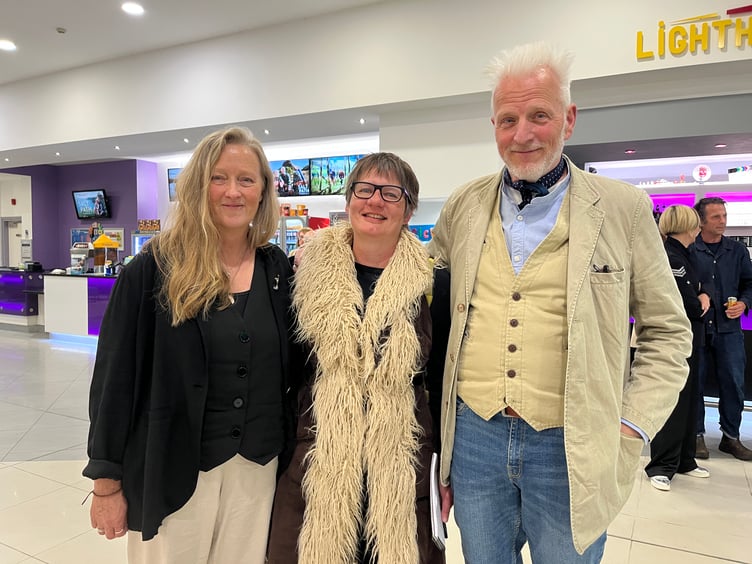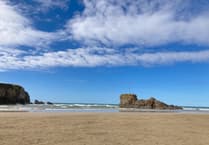EARLIER this month, I was lucky to be invited to the UK gala premiere of the film adaptation of The Salt Path - Raynor Winn’s life-affirming memoir of her 630-mile trek with husband Moth around the South West Coast Path.
The couple had endured the double blow of losing their home and Moth’s diagnosis with the progressive illness CBD. The path gifted the pair a nomadic existence under canvas rather than bricks and mortar, with the unexpected bonus of the physical exercise being beneficial to Moth’s health.
The screening took place at the Lighthouse Cinema in Newquay. Stars Gillian Anderson and Jason Isaac were absent, but Raynor and Moth were in attendance, joined by director Marianne Elliot (best known for theatre work including War Horse and The Curious Incident of the Dog in the Night-Time) and producer Elizabeth Karlsen, and the great and the good of Cornwall – I even spotted a Fisherman’s Friend.
The London team behind the film were determined to bring a bit of Leicester Square to Cornwall, and we journalists were presented with a strip of red carpet on which to interview “the talent”. It was all rather surreal.
Having very much enjoyed the book and written several pieces in the run-up to the film’s release, I was keen to see how it translated onto the screen. I had a vested interest; as well as living in Cornwall, my mum’s partner suffered from PSP, the twin condition to CBD. A portion of premiere proceeds was donated to the PSP Association, the umbrella charity that raises awareness and funds for these aggressive Parkinsonian conditions.
I managed my expectations, having seen a few locally shot films in my time. They have been hit and miss to say the least, with Churchill: The Hollywood Years standing out in my memory. Starring Christian Slater as the titular prime minister, with locations including Plymouth’s Royal William Yard and Paignton’s Oldway Mansion standing in for Buckingham Palace, it was widely panned by audiences. “That’s a couple of hours we won’t get back,” quipped one viewer at the (largely empty) sitting I attended.
And screenwriters can take liberties with the source material; a recent cinema release of The Secret Garden left me fuming with its unnecessary tweaks and elaborate back stories.
So I awaited The Salt Path with baited breath – and was really impressed. As you might expect, the lush land- and seascapes of North Devon and South East Cornwall were a cinematographer’s dream, with drone shots a go-go absolutely singing with colour and atmosphere, to the point that you could smell the gorse and taste the spray on your lips.
The script by Plymothian Rebecca Lenkiewicz was sparse enough to let the scenery do most of the talking, while evoking the Winns’ suffering with great empathy. To see this film is to truly understand the shame of homelessness and the devastation of a terminal prognosis, countered by the resilience of those with little left to lose.
The leads also did a great job of portraying the kind of close-knit, long-term relationship in which words are surplus to requirements: a discreet look speaks volumes, and the smallest of gestures – the illicit sharing of a teabag, the carrying of a backpack - makes the biggest of differences.
It’s a classic tale of triumph in the face of adversity. Ray and Moth put one foot in front of the other and take each day as it comes, and by sheer good fortune, they did this in the most photogenic part of the UK (no arguments).
From lush verdant woodland to a clifftop in the teeth of a wild storm, the South West Coast Path is achingly gorgeous and justifiably described as “the third character in the film”. It was fun trying to spot identifiable locations, from Hawker’s Hut and Doyden Castle in North Cornwall to Rame Head in the south - not always in the right order but let’s not be picky; and local actors including Jason Gerdes as a walker on a mission in a hurry. The Salt Path’s message is surely to take your time – this was slow cinema in more ways than one.
The buzz in the lobby afterwards told you all you needed to know about how the film had gone down. Granted, my colleague wasn’t best pleased at how Newquay was portrayed – the book, too, suggests the author’s urban experience of homelessness was tougher than on the coast, which is hardly surprising.
And while it was weird to see “Ray and Moth” having sex on screen in the knowledge that the real deal was in the room, it was great talking to Moth afterwards – having been given five years to live by experts, he is still looking good a decade on, albeit with ups and downs.
The Salt Path is released to the public on May 30. My advice? Book your ticket, now.





Comments
This article has no comments yet. Be the first to leave a comment.